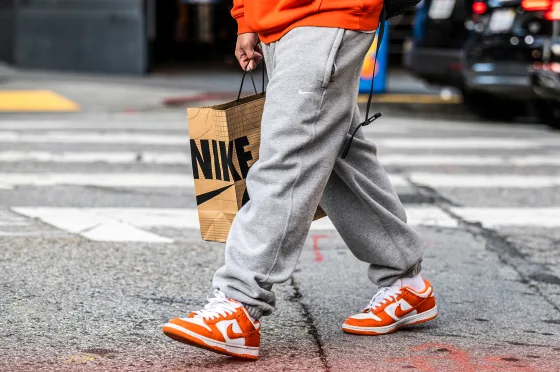The global footwear giant, Nike, is reeling from a dramatic $10 billion market value loss, triggered by President Donald Trump’s newly imposed tariffs on key U.S. trading partners. These tariffs, particularly those targeting Vietnam and China, have sent shockwaves through the apparel and footwear industries, resulting in a 13% pre-market stock plunge for Nike on Thursday.
President Trump’s “Liberation Day” press conference, where he unveiled these sweeping trade measures, has ignited fears of significant disruptions to global supply chains. According to Nike’s fiscal 2024 report, nearly half of its footwear is manufactured in Vietnam, which now faces a 46% tariff on exports to the United States. China, another vital supplier, will see a 34% tariff, compounding existing trade pressures.
“The immediate market reaction underscores the severity of these tariffs,” says financial analyst, Johnathan Wells. “Investors are concerned about the long-term impact on companies heavily reliant on these manufacturing hubs.”
This financial turbulence isn’t exclusive to Nike. Lululemon, known for its athleisure wear, saw its shares drop by nearly 15%, while Deckers, the parent company of Uggs and Hoka sneakers, experienced a 14% decline. Retailers like American Eagle and Abercrombie & Fitch also suffered significant losses, with their shares falling 9% and 11%, respectively.
Read Also: Trump’s “Reciprocal Tariffs” Ignite Global Trade Tensions, Nigeria Impacted
Nike’s fiscal 2025 results further accentuate the strain. The company reported a 28% drop in net income, totaling $3 billion, a stark contrast to the previous year. As of Thursday, Nike’s stock valuation has plummeted to levels not seen since 2013, falling to just below two times sales.
Goldman Sachs reports that the U.S. imports approximately 51% of its apparel and footwear from China and Vietnam. The new tariffs are anticipated to drive up consumer prices, potentially dampening demand and squeezing profit margins for companies like Nike. Lululemon, which sources 40% of its products from Vietnam and 17% from Cambodia (facing a 49% tariff), is particularly vulnerable. Analysts predict a potential 7% margin hit if the company doesn’t take mitigating action.
The implications extend beyond mere financial figures. These tariffs will likely translate to higher prices for everyday consumers, impacting their purchasing power. As these tariffs gradually roll out, with the baseline 10% tariff beginning on Saturday and country-specific levies following in April, the apparel and footwear industries are bracing for a period of considerable uncertainty. Companies like Nike must now strategize to navigate these challenges, potentially through supply chain adjustments, cost-cutting measures, or even price increases.
“For consumers, this could mean paying more for their favorite sneakers and athletic wear,” I observed, “It’s a challenging time for both companies and consumers.”
The ability of these companies to adapt and innovate will determine their resilience in the face of these new trade policies. The coming months will be crucial in observing how these tariffs reshape the global apparel and footwear landscape.













